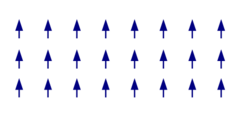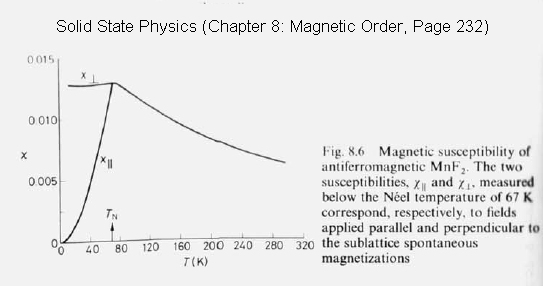Solution to Set 3: Difference between revisions
(Link to local bipartite lattice wiki) |
(Infobox, Given Information, Problem #1) |
||
| Line 9: | Line 9: | ||
{| align="center" border="0" cellpadding="5" cellspacing="0" width="240" | {| align="center" border="0" cellpadding="5" cellspacing="0" width="240" | ||
! colspan="2" style="background:#ccffff;"| Books | ! colspan="2" style="background:#ccffff;"| Books | ||
|- | |- valign="top" | ||
| '''Topics''' | | '''Topics''' | ||
| Magnetic Order <br> Ferromagnetism <br> Weiss field. | | Magnetic Order <br> Ferromagnetism <br> Weiss field. | ||
|- | |- valign="top" | ||
| '''Solid State Physics''' | | '''Solid State Physics''' | ||
| Section 8.3 <br> Section 8.4 | | Section 8.3 <br> Section 8.4 | ||
|- | |- valign="top" | ||
| '''Soft Condensed Matter''' | | '''Soft Condensed Matter''' | ||
| Section 3.2 | | Section 3.2 | ||
| Line 26: | Line 26: | ||
* Classical Ising antiferromagnet on a [[Bipartite lattice|”bipartite” lattice]] given by Hamiltonian <math> H = \frac{J}{2} \sum_{<ij>} S_i S_j -− h\sum_i S_i </math>, | * Classical Ising antiferromagnet on a [[Bipartite lattice|”bipartite” lattice]] given by Hamiltonian <math> H = \frac{J}{2} \sum_{<ij>} S_i S_j -− h\sum_i S_i </math>, | ||
* Magnetization for Lattice A: <math> m_A = < S^{(A)} > </math> | * Magnetization for Lattice A: <math> m_A = < S^{(A)} > </math> | ||
| Line 35: | Line 33: | ||
* Average magnetization: <math>m = \frac{1}{2} (m_A + m_B ),</math> | * Average magnetization: <math>m = \frac{1}{2} (m_A + m_B ),</math> | ||
* "Staggered” magnetization: <math>m^{\dagger} = \frac{1}{2} (m_A - m_B ),</math> (''Note: It's the difference between the two sublattices'') | * "Staggered” magnetization: <math>m^{\dagger} = \frac{1}{2} (m_A - m_B ),</math> | ||
(''Note: It's the difference between the two sublattices'') | |||
* <math>m = 1\;</math> for perfect ferromagnetic order | * <math>m = 1\;</math> for perfect ferromagnetic order | ||
| Line 50: | Line 49: | ||
<math> S_i = < S > + (S_i - < S >) </math> and <math> S_j = < S > + (S_j - < S >) </math> into | <math> S_i = < S > + (S_i - < S >) </math> and <math> S_j = < S > + (S_j - < S >) </math> into | ||
<math> H = \frac{J}{2} \sum_{<ij>} S_i S_j -− h\sum_i S_i </math> | <math> H = \frac{J}{2} \sum_{<ij>} S_i S_j -− h\sum_i S_i </math> | ||
<!-- EVERYTHING BELOW IS COMMENTED OUT | |||
The answer becomes | The answer becomes | ||
| Line 59: | Line 60: | ||
<font color=red>'''I do not like what you have done here. You are copying from some source, rather then solving the problem I have assigned, following the approach described in lectures. This needs to be redone.''' </font> | <font color=red>'''I do not like what you have done here. You are copying from some source, rather then solving the problem I have assigned, following the approach described in lectures. This needs to be redone.''' </font> | ||
EVERYTHING ABOVE IS COMMENTED OUT --> | |||
==Part 2== | ==Part 2== | ||
Revision as of 21:51, 8 February 2009
Ferromagnetism
| ||||||||
Given Information
- Classical Ising antiferromagnet on a ”bipartite” lattice given by Hamiltonian Failed to parse (syntax error): {\displaystyle H = \frac{J}{2} \sum_{<ij>} S_i S_j -− h\sum_i S_i } ,
- Magnetization for Lattice A:
- Magnetization for Lattice B:
- Average magnetization:
- "Staggered” magnetization:
(Note: It's the difference between the two sublattices)
- for perfect ferromagnetic order
- for perfect antiferromagnetic order
Part 1
Use Weiss mean-field decoupling to replace one of the spins in the Hamiltonian by its thermal average. The Weiss field experienced by a given spin is then proportional to the sublattice magnetization on the other sublattice. Write down self-consistent equations for and , and express them through the order parameters and .
The Weiss Molecular Field
Chapter 8.3.1 of Solid State Physics The systematic way of replacing the spin operator in the Heisenberg Hamiltonian by their average values in order to obtain the Weiss molecular field approximation is to insert and into Failed to parse (syntax error): {\displaystyle H = \frac{J}{2} \sum_{<ij>} S_i S_j -− h\sum_i S_i }
Part 2
Assume that , so that , and solve the mean-field equations by expanding in . Determine the Neel (ordering) temperature, and calculate the order-parameter exponent.
The Néel Temperature
Chapter 8.4 of Solid State Physics
where
- is Néel Temperature, the onset temperature for antiferromagnetism
- is Curie constant
Part 3
Now consider a small external field , so that both order parameters can assume a nonzero value (Note: will be small). By keeping only the leading terms in and , calculate the uniform spin susceptibility , as a function of temperature. Plot as a function of temperature, and show that it has a cusp around .
Part 4
Imagine adding a ”staggered” external field , which would be positive on sublattice A, but would be negative on sublattice B. Concentrate on the system with no uniform field , and determine the behavior of the staggered susceptibility . Show that blows up at the Neel temperature.



























